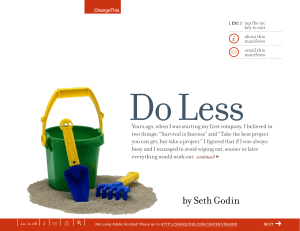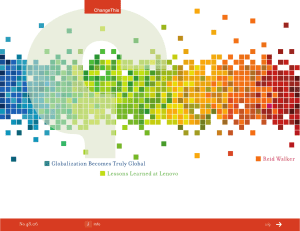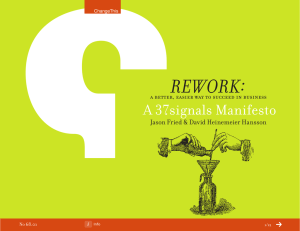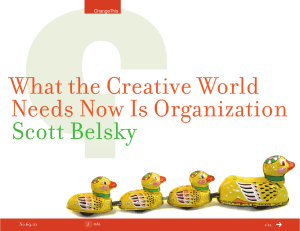Taking Higher Education Higher Sharla Berry
advertisement
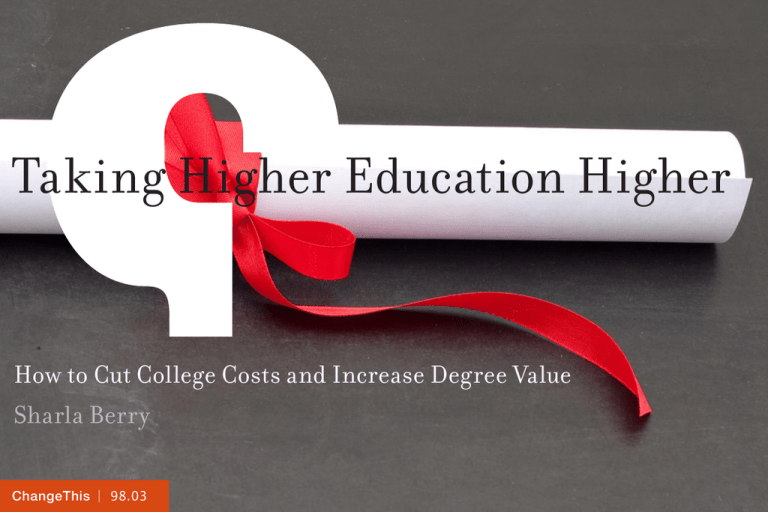
Taking Higher Education Higher How to Cut College Costs and Increase Degree Value Sharla Berry ChangeThis | 98.03 College. What comes to mind when you hear the word? Is college a constant grind or four years of fun? Is it a place to embrace new ideas or is it a sea of conformity and requirements? Does it prepare you for the real world or is it a paradise separated from reality? Is it a worthwhile investment or a source of financial angst? For me, it was a place where the philosophical met the practical. For every high-minded idea, there was a class, service opportunity, or club where I could put my ideas to the test. There was generous funding for meaningful work experiences and I was always encouraged to think about life after the university. My experience makes me a staunch defender of the practices and promise of the university. ChangeThis | 98.03 However, my experience is not universal. With college costs rising, student loan debt skyrocketing and average starting salaries falling, the following questions must be asked. Is college for everybody? Is college for you? Who is college for? What types of experiences should students pursue that will make them more competitive in the job market? In the midst of great economic and cultural change, what is the role of the university? What are the roles of the student, and of the student’s family, in picking a college to attend? Policy wonks will issue decrees on change and pundits will debate them. Traditionalists will write odes to the university of the past, and visionaries will dream of a university of the future. This manifesto is about the architects of the present—those that are rethinking and rebuilding the system from within, brick by brick. This manifesto seeks to identify some steps that colleges, students, and families can take to make education more affordable and accessible for students, and give them more of what they need to succeed in the present and future economy. It is also about how students can take control of the current educational system and make college a more sound investment than it is presently. This manifesto is for those who are willing to begin the work of change. It is widely agreed that a college degree brings great value to the economic prospects of an individual. Over a lifetime, a college degree does have its benefits. College graduates are expected to earn nearly $1 million more in a lifetime than those without college degrees. ChangeThis | 98.03 However, this million dollar gain is not earned free and clear. Student loan debt has risen tremendously. The inability to earn fulltime work and gainful employment results in nearly half of all young adults saying that they do not feel they will do as well as the previous generation. “ With college costs rising, student loan debt skyrocketing and average starting salaries falling, the following questions must be asked. Is college for everybody? Is college for you? However, for students willing to change their approach to education, there is hope. No longer can students be passive recipients of a university education. Today’s college student must be willing to be his or her own primary professor and academic advisor. He or she cannot wait for a syllabus to outline what to learn and when, and cannot use grades as the chief indicator of success or knowledge. Instead, today’s college student must be willing to use the university to define their own course of study, find or create unique work experiences, and build skills. In that same vein, today’s colleges must work harder at helping students bridge the gap between theory and practice, and must develop new ways to help students learn through doing. At the same time, students, families, and universities need to find ways to cut costs and reduce the financial burden on students. ChangeThis | 98.03 What is the purpose of college? As we decide who should go to college and how they should go about it, we must ask the question—what is the purpose of college? Is it a time to learn for learning’s sake? Is it time to build your network for prospective business and romantic partners? Is it a place to prepare for a job? Is it a place to wholeheartedly pursue knowledge, ideas, and dreams? Is it a place to indulge in four years of fun? To the savvy and focused student, it is all of those things and more. However, something must be done to help students participate in this great social experience with greater balance. Something must be done to prevent students from simply taking a flurry of classes, sliding down a hole of debt, and emerging none the wiser. Students should be able to pursue their dreams and get prepared for the job market. Ideally, to make this happen, there would be an increase in state and federal financial aid for students. There would also be a cap on the rising costs of private colleges. Private loans with high interest rates would come under greater scrutiny. Those changes are happening, but they are not keeping pace with the present increase in costs. Still, the question remains. What can universities, students, and families do to add value to a college degree, so that it is a more meaningful investment in the future? ChangeThis | 98.03 The first thing to do is to simply ask the question. We all know the ubiquitous question about college. It draws spurn and confusion from students, parents, and faculty. Students and their professors often ignore it, though it will permanently alter the path of so many undergrads. It is: “What are you going to do with that degree?” It was a question few people asked me. As I bounced from major to major, family and friends were content with my lofty goals of saving the world, starting a business and owning a home—even though I had no clear path toward these goals, and my academic program wasn’t helping me gain skills or experience that would lead to doing so. For so many, it is rude to point out the futility of majoring in certain things that do not directly develop skills, or for which there are declining job opportunities. The reality now is that students cannot afford not to ask that question. The question shouldn’t be asked to turn students away from liberal arts disciplines, or to focus on fields that are of the highest demand. Rather, the question is asked so that students can supplement the theoretical with the practical. While students seek to follow their passions, they should also seek the skills and experiences that help them put that passion into practice while they are still in college. ChangeThis | 98.03 Students shouldn’t be pressured into pursuing career fields that they have no interest in because of the allure of higher salaries. Law degrees, once thought a safe haven for those looking to secure six-figure salaries, are subject to a similar trend as liberal arts degrees, with declining salaries and increasing debt. I still believe that students should choose a course of study based on skill and passion, not based on trend or convention. However, students should be heavily prompted to think about life beyond college, and acquire the real life skills that will help them get or create jobs. It is not simply the acquisition of the degree that gives it worth; it is the added value of experience that makes college an investment. It is therefore of the utmost importance that the college experience actually adds value to the student’s life. The initial question of whether or not a student should go to college is oversimplified and unnecessary. Yes, students should go to college, if for no other reason than the fact that many jobs require a college degree. The question then is “What will students do once they get to college?” It is no longer acceptable for students enter school, take a smattering of disconnected humanities classes, write a few papers, and emerge on the other side with only a degree and a mountain of debt. The university must go further. ChangeThis | 98.03 Backwards Planning Presently, many universities work like this. Students pick their interests: art, science, humanities, business. These interests are placed into narrow categories, or majors. Students take the required coursework in these disciplines, and in four years time they are deemed competent in the field. Other universities require all students to take a wide variety of classes at the start of college. The idea is that these theoretical courses, called the core curriculum, will lead students toward picking a field that they would like to pursue for their career. After two years, students pick a discipline from amongst those core subjects and pursue it. In the last year, they may get hands on experience in this field. At the end of their four years, they are deemed competent. “ The initial question of whether or not a student should go to college is oversimplified and unnecessary. Yes, students should go to college, if for no other reason than the fact that many jobs require a college degree. The question then is “What will students do once they get to college?” ChangeThis | 98.03 What if the university adopted a backwards plan? Instead of spending the last two years specializing, interning and working, what if students spent the first two years looking toward the practical aspects of their future? What if students picked several careers or life paths they would like to take, and spent the start of college connecting with others that had embarked upon that path? Through research, shadowing professionals in the field, and interning in their interests, students could determine if that particular path was for them. Then, students could handpick courses from the universities core curriculum and develop the specific knowledge needed for the career path of their choice—or create a new path altogether. The idea of backwards planning would not radically alter the university, but it would radically change student experiences. The Role of the University Simply put, college degrees should not be granted without internships, fellowships, or a work experience component. Work experience should be embedded into the curriculum—not placed as an elective. The same way that teachers and clinicians do fieldwork before earning licensing, undergraduates should be required to have meaningful work experience related to their major before graduating. A work experience component in every academic program should be a requirement for accreditation at all universities. This would be a major step in providing students with adequate preparation for the job market. ChangeThis | 98.03 Not only should the university require and support a form of work experience as a requirement for a degree, the university should advocate for internships to turn into full time job positions upon graduation. Schools may even seek to form a reciprocity agreement with certain organizations—we will train students to be interns, they will work for a certain time at a discounted rate, we will give them academic credit, and you will eventually give them a position. If the purpose of college is to prepare students for the workforce, then colleges need to do more to increase student’s access to the workforce. Not only should they increase access, their rank should be based on their ability to help students procure employment. Just as high schools are assessed on their college acceptance rate, universities should be judged by the percentage of graduates acquiring jobs in their fields within a year of graduation. Jobs should be lined up in the student’s field at competitive wages. Data should be published, and schools should be ranked on their ability to get jobs for their graduates. Colleges should act as job placement agencies for their students. Starting in a student’s first year, colleges should meet with students to review their goals. They should work with students to devise plans to meet these career goals—a combination of academic and extracurricular advising. In the sophomore and junior years of college, they should identify the gaps in student’s resumes and CVs and advise them on how to fill them in through work-study, volunteering, study abroad, and other experiences. Then, in their senior year, college advisors should work with students ChangeThis | 98.03 to apply for jobs. Job placement should not only be for students who seek it, but should be a part of the culmination process for all students. For students who wish to go into business for themselves, whether they be artists or entrepreneurs, there should be a mentoring and training process with alumni and people from the community that have done so successfully. If colleges aim to prepare students for the workforce, then they must be intentional about connecting students with job creators, particularly within the alumni network. University outreach to alumni must go beyond recruiting donors. The university must help students form meaningful, one-on-one partnerships with alums. Similar to the Big Brother and Big Sister program, colleges should pair students with recent and seasoned graduates who have interests similar to the students. Current students should know that acceptance into this university comes with a mentoring commitment. Alumni should be tapped not only for money, but for time connecting with current students. These are just a few steps that the university can take to help make college degrees more valuable. As universities continue to compete for the most talented applicants, certainly more will emerge. There are also things individuals must do if they want to earn a value added, low cost degree. ChangeThis | 98.03 The Typical College Entrance Plan— Problems and Solutions Many students take a generalist approach to applying to college. They do the things that would make them widely competitive (foreign language, extra-curricular activity, etc.) and then apply to a wide variety of schools, hoping they will get in. They think of why a particular school might be a good fit for them (sports team, major, location), but they cannot articulate why they would be an asset to the school. For many students, cutting college costs will mean earning scholarships for school. If you want to earn a scholarship, and pay a low or no out of pocket cost for your degree, then you need to think like a recruiter. Students need to be trained to identify the needs of college campuses. Figuring out the types of students the university is interested in, the level of need for particular students, and then tailoring your path in high school toward that is a good way to make yourself more desirable for a scholarship. Simply saying, “I’m smart, let me in to your school” isn’t enough. Students need to know how to identify and apply to schools that are a strong fit for people just like them. Colleges are skilled at finding academic fits for their school. The field of admissions rests on being able to pick people who will want to go to your school and who will stay in and ChangeThis | 98.03 graduate from it. They can be less skilled at finding a financial fit. To be fair, colleges do their best to provide aid packages for students that combine scholarships, government aid and loans. However, for some families, the aid offered by schools is not enough. In trying to make school affordable for students, should colleges say no to students who really can’t afford their schools? In the class of 2011, 10 percent of students owed more than $54,000 in loan debt, and 3 percent owed more than $100,000. Should students who cannot afford a particular college be counseled out of enrolling in that school? To be fair, the burden of such counseling is equally on parents. It is unfair to place the decision on the shoulders of an 18 year old who cannot fully grasp the implications of having loan debt that is more than rent. It is honorable of parents to help students realize their dreams of academic achievement, but it is irresponsible to clip student’s wings with debt before they can even fly. We cannot go on thinking that all a student needs to do is get into school, and let the funding come as it will. Enrolling in school for one year and hoping to pay through the next through scholarships not yet acquired, private loans with large interest rates, credit cards or other risky practices are all gambles that are too big to take. The idea that students and families should fund their dream school through any means necessary no longer serves students’ best interests. ChangeThis | 98.03 We are in need of a paradigm shift. When the cost of a particular school is too high and scholarships are not forthcoming, families need to learn to reevaluate the choice of whether or not to attend. Unfortunately, it seems that the age of everyone attending their “dream” school is now over. It is too costly, and the results are too uncertain. Families must now focus on the “do” school— the school that a student can complete given their financial present that will also provide a stable financial future. For some, this may mean a public school offering a mix of state and federal grants. For others, it means a lesser-known private school with scholarships tailored to that particular student. The stigma against lesser-known schools and the idea that the higher the cost, the better the school, must end. The best school is the school you can afford, not the school that will look good on your license plate holder. “ Simply saying, “I’m smart, let me in to your school” isn’t enough. Students need to know how to identify and apply to schools that are a strong fit for people just like them. ChangeThis | 98.03 How To Get a Degree for Free If you want to get a degree for free, the answer is simple but overlooked—find the best fit and then court it. Pick a school where you will be highly competitive. Even if you are not a top student, find a school where you will be among the top. Find a place that caters to your skills, interests and accomplishments. Build connections with that school, and make yourself known even before applying. Showing a school early on why you will be an asset to them will greatly increase your odds of getting funding. If a student feels that the best school for them is financially out of reach, they should still make all efforts to go. But they should not feel bad if they turn down their dream school in favor of a better financial choice. Its not about the school you get into, its about the school you graduate from, the experience you get, and the position you’re in when you leave. Finding the Funds If college students are going to go to schools they are priced out of, they need to take acquiring financial aid as seriously as the college application process. The days of waiting for a glamorous aid package are over. Students will need to sell cookies, mow lawns, launch community wide ChangeThis | 98.03 fundraising drives, and personally court trustees to get the money they need. The savvy student must go local and go big. Community support is a great way to get funding for college, and it cannot be underestimated. In college, I watched friends pour over 10 page applications for $10,000 corporate scholarships. Most of them got rejected, simply because there was not enough to go around. However, I sought out very small scholarships of $100 to $1000, and earned $10,000 my first year of school. Just like seeking name brand colleges is not always the best bet, going after widely known, competitive scholarships is not a foolproof strategy for paying for college either. Working on campus is also another great way to earn money for school. Many student housing departments at schools have programs where students can be Resident Advisors, living in the dorms and assisting students. Some programs pay for housing and meal plans for students, which can be 1/3 of college costs. In the fight for student aid that works, programs like this need to be increased, with priority going to students with the greatest financial need. Like college aid, the college experience is itself a paradox. While students seek to create identities for themselves, they also participate in a number of group activities that make them more similar than different. From taking the same coursework and earning the same grades, to joining the same sororities and fraternities, participating in them in the same way, and pursuing the same ChangeThis | 98.03 extracurricular activities, college students do little to set themselves apart from the pack once they reach college. Acquiring increased aid while in college and improving opportunities in the postgraduate job market means breaking away from the pack early and distinguishing yourself through doing something noteworthy. Word to the wise: if you see everybody doing it, don’t do it. If everyone on your floor is in the same sorority, pursuing the same course of study, doing the same intramurals and clubs, either find out how you can make yourself stand out in these organizations or find others to join—even lead. Developing skills, and finding and creating leadership opportunities is just as important as having fun. Leadership is the greatest way to add value to a college degree. If you can be in charge of anything, do it! So what if your club had two members. You were still the president, and you have an experience that no one else can claim! Leadership is your calling card to a real job. True, you won’t be CEO or manager when you first graduate, but if you can prove you’ve already done it, you are on your way there. College students serious about adding value to a degree must find, and create, ways to lead. College is a time of great freedom, but for many it represents a scripted reality. Many students follow the proscribed path of recommended classes and extracurricular activities. But college ChangeThis | 98.03 is not the time for convention. College is a safe place to explore the ideas that the “real world” will deem too risky. So be bold. Be random. Many great bands form in college, and new startups are forming in dorm rooms daily. For most students, there will never be a time outside of college where you will be surrounded by so many creative, educated people, so much encouragement for innovation, and so much of the financial and social capital to make a dream come true. Don’t get so caught up in coursework that you neglect the education that comes through trial and error. Creating Value— Making Your Degree Worth Something One of the biggest complaints I hear from recent grads is that “college didn’t prepare us for … .” Its true, college doesn’t always prepare you for “real world” skills. College teaches you how to think, gives you new lenses with which to view the world, and unique experiences to shape your future. It is the shared responsibility of the university and the student to prepare the student for the real world. College does not stop students from gaining practical experience, and the student who wants to add value to their degree will seek growth in every opportunity. ChangeThis | 98.03 If you are a student, what are you waiting for? Are you waiting for college to place opportunities at your doorstep, or are you willing to use the university as a safe place to pursue your dreams? Will you spend four years studying business and never start one? Will you learn about making movies but never submit to a film festival? Will you learn about sociology but not get a chance to help someone solve his or her problems? If so, college for you will be a pipeline to graduate school, which may or may not lead to a career. Nothing in the design of the university suggests that an individual can’t add value to his or her own degree. If you are in college, you have the prime opportunity to pick something great to do and just do it. You can identify the skills you want to develop, and seek out professors for support and guidance. You will be rare and distinguished if you do. “ College teaches you how to think, gives you new lenses with which to view the world, and unique experiences to shape your future. It is the shared responsibility of the university and the student to prepare the student for the real world. ChangeThis | 98.03 Just as students should ask the university what skills a degree will equip them with and what jobs their course of study will prepare them for, students need to ask themselves what they want to do and what actual skills are needed to get there. Accounting, film editing, computer programming, health care skills, construction, art skills, and management can all be learned in college, though they may not be explicitly listed on anyone’s syllabus. In addition to thinking about classes to take, students who are serious about adding value to a degree must be constantly reflective about what skills they have acquired. In the university of the future, students will take their academic path into their own hands. Students won’t wait on coursework as the sole source of education, but will seek out work experience and leadership opportunities to prepare them for postgraduate life. The university will support them by providing access to high quality work experiences during and after college, and with financial and academic advising to help students align present goals with future needs. Students, families, and schools will be more proactive in preparing students for the world they enter into upon graduating, and in limiting the financial constraints to realizing dreams during and after college. ChangeThis | 98.03 The university of the future will have a place for everyone—high and low income, struggling and standout students. Programs will be tailored to help students meet the needs of the workforce, but will also continue to encourage inspiration and innovation. The university of the future will prepare students for the world as it is and help them fashion the world as we wish it to be. In the end, the beauty of the college experience is that it is as different as the number of universities there are and students within them. One thing remains: college is a place where students can be creative and take the reigns of their own experiences. The college system provides opportunities to gain skills, make connections, work in a meaningful capacity and do bold things that will shape society at large. When students and universities devote more time to doing these things, a college education will be priceless. ChangeThis | 98.03 Info About the Author | Sharla Berry is a 23 year old public school teacher and writer from Los An- geles, CA. She aims to change the educational landscape by making higher education more affordable, accessible and relevant to students of all backgrounds. ➔ Send this | Pass along a copy of this manifesto to others. ➔ Subscribe | Sign up for e-news to learn when our latest manifestos are available. This document was created on September 12, 2012 and is based on the best information available at that time. The copyright of this work belongs to the author, who is solely responsible for the content. This work is licensed under the Creative Commons Attribution-NonCommercial-NoDerivs License. To view a copy of this license, visit Creative Commons or send a letter to Creative Commons, 559 Nathan Abbott Way, Stanford, California 94305, USA. Cover image from Veer. You are given the unlimited right to print this manifesto and to distribute it electronically (via email, your website, or any other means). You can print out pages and put them in your favorite coffee shop’s windows or your doctor’s waiting room. You can transcribe the author’s words onto the sidewalk, or you can hand out copies to everyone you meet. You may not alter this manifesto in any way, though, and you may not charge for it. ChangeThis | 98.03 About ChangeThis ChangeThis is a vehicle, not a publisher. We make it easy for big ideas to spread. While the authors we work with are responsible for their own work, they don’t necessarily agree with everything available in ChangeThis format. But you knew that already. ChangeThis is supported by the love and tender care of 800-CEO-READ. Visit us at 800-CEO-READ or at our daily blog. Explore your knowledge further with KnowledgeBlocks, a new project from 800-CEO-READ that lets you turn what you know into knowledge you can use. ChangeThis | 98.03


